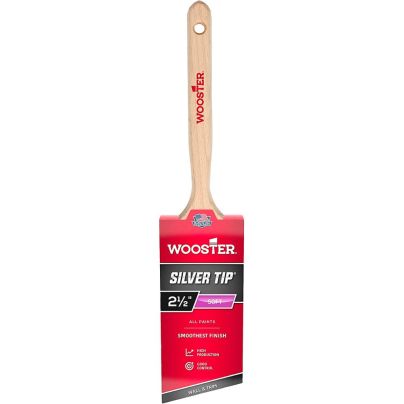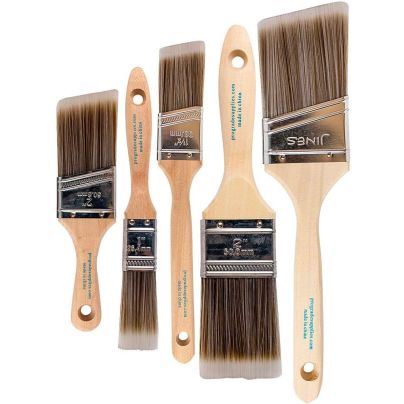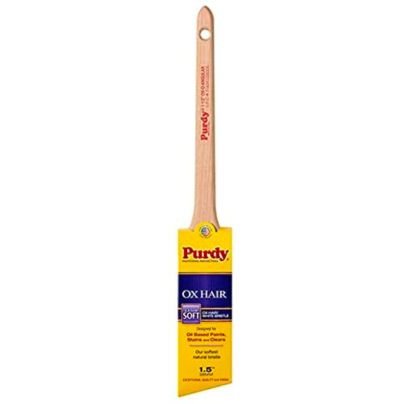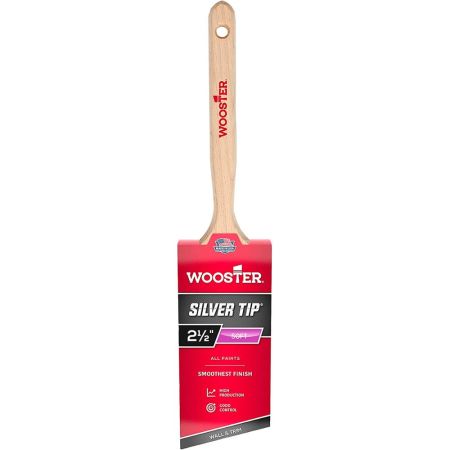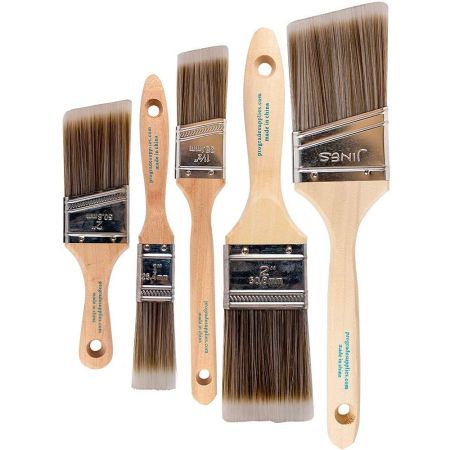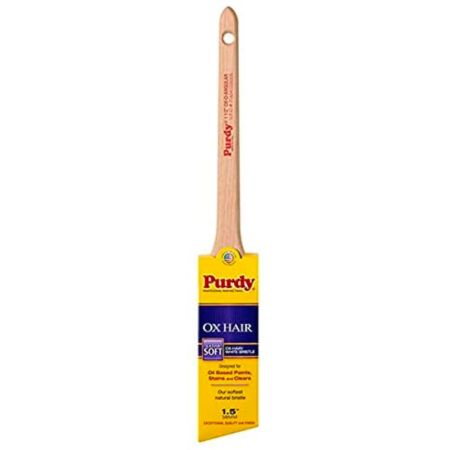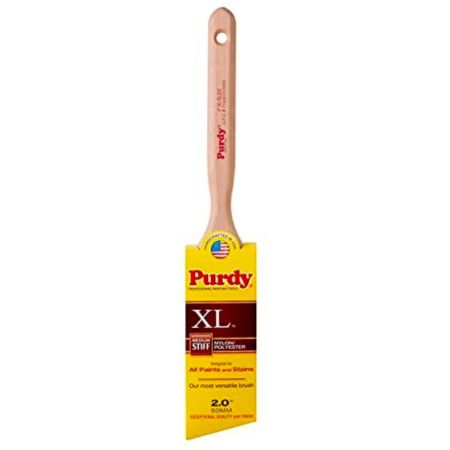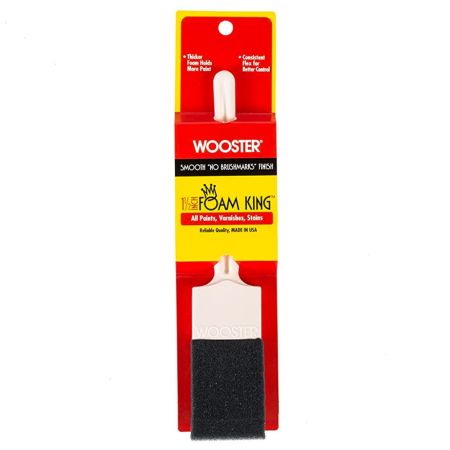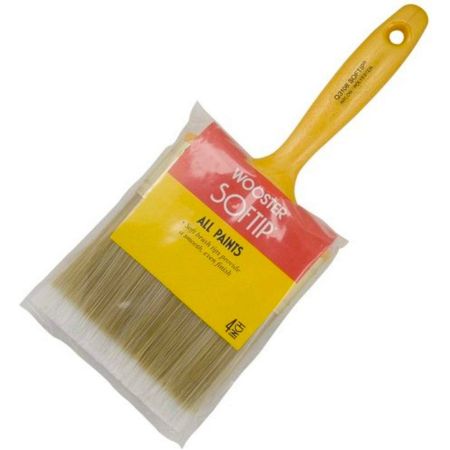We may earn revenue from the products available on this page and participate in affiliate programs. Learn More ›
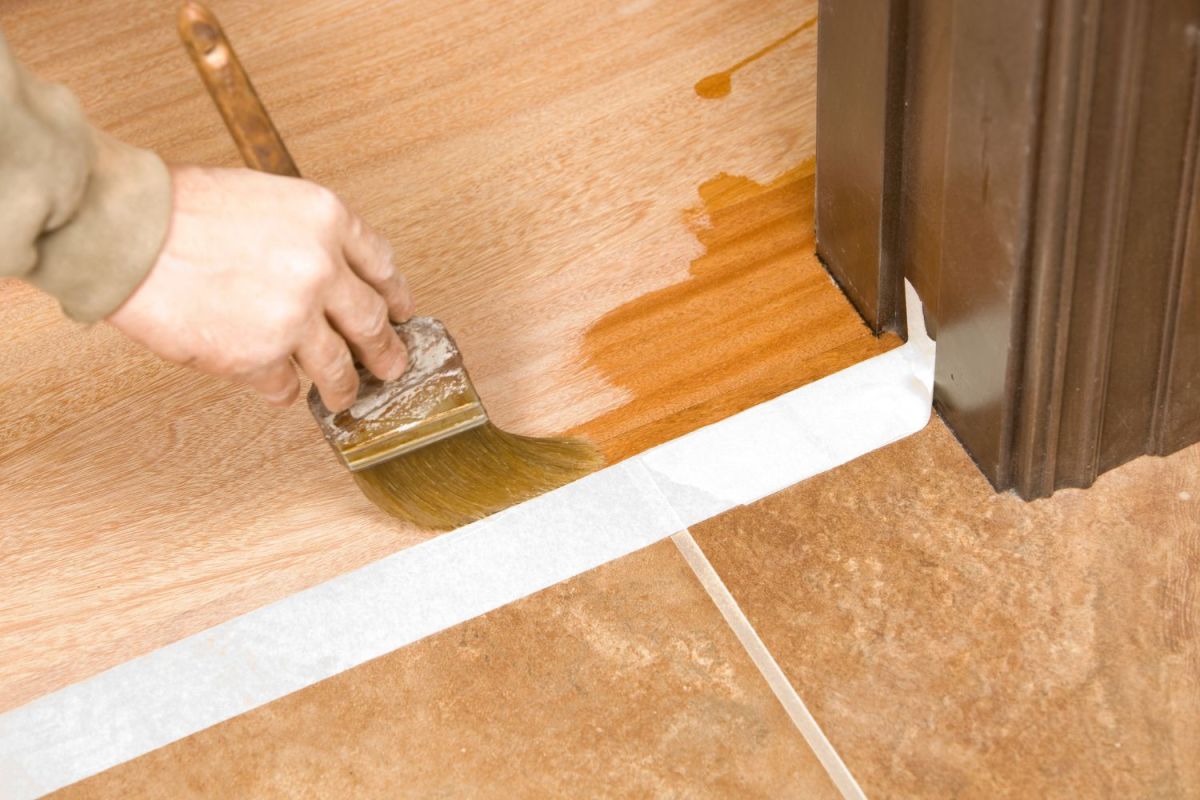
The best polyurethane provides a durable, attractive finish that comes in several formulas, including oil-based, water-based, and water-based and oil modified. It’s typically used to seal wood products, protecting them from moisture, dirt, and damage. Like paint, polyurethane is applied to the material’s surface with a brush.
The best brush for applying polyurethane differs depending on the intended application. Most smaller projects benefit from a narrow brush, while larger projects can be completed with a wider brush. Read on to learn about the factors to consider as you shop, and then explore some of the top choices for the best brush for polyurethane application.
- BEST OVERALL: Wooster Brush 5221 2½-In. Silver Tip Angle Sash Brush
- BEST BANG FOR THE BUCK: Pro Grade Set of 5 Paint Brushes
- BEST NATURAL-BRISTLE: Purdy 144296015 Ox-Hair Series Ox-O Angular Brush
- BEST SYNTHETIC-BRISTLE: Purdy 144152320 XL Glide Angled Sash Brush
- BEST FOAM BRUSH: Wooster 1½-In. Foam King Foam Brush
- BEST HIGH-COVERAGE: Wooster Q3108 Softip 4-In. Paint Brush
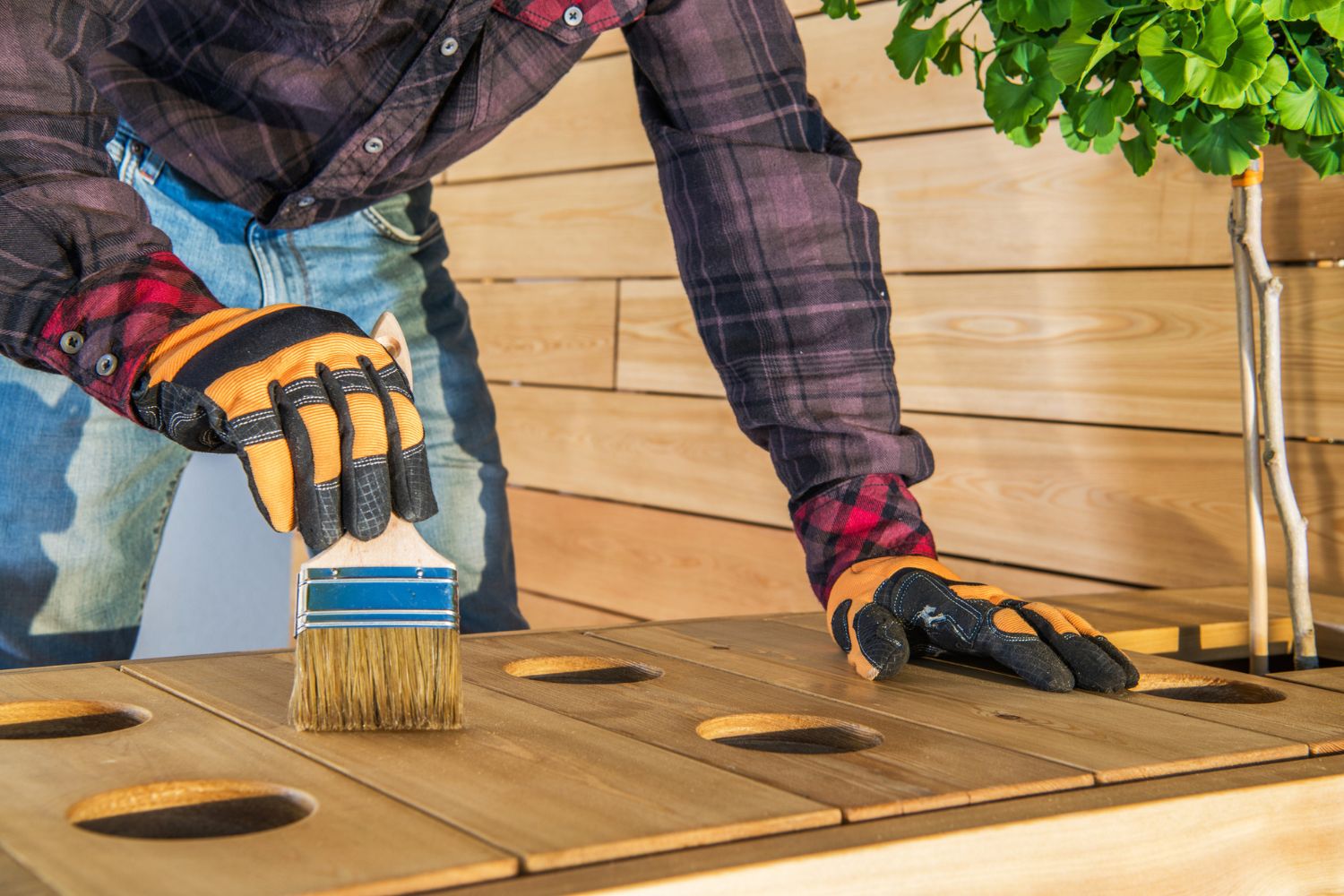
How We Chose the Best Brushes for Polyurethane
We researched the most sought-after brushes for polyurethane in their respective categories and discovered that the best options are determined by their bristles, design, width, compatibility with multiple paints and sealants, and other special features included by top brands.
While searching for the best paint brushes for polyurethane applications, the most popular types among users were the synthetic, natural, and foam options for their versatility and ease of use while applying paint as well as water- and oil-based polyurethanes. The brushes listed above vary from angled (tapered) to flat designs with 1- to 4-inch widths to take care of different application types and projects, whether applying thin coats or thick coverage.
As for durability, stainless steel, brushed-steel, copper, and plastic ferrules hold in these brushes’ bristles to prevent shedding, and wooden and plastic handles make these picks lightweight and maneuverable while in use. Plus, some of our top picks provide a smooth finish with paints and sealants like lacquer, varnish, and enamel.
Our Top Picks
Here’s a look at some of the top products on the market so users can find the best way to apply polyurethane. This list includes all three main options—natural bristle, synthetic bristle, and foam—to help users find the best brush for polyurethane application.
Best Overall
Wooster Brush 5221 2½-In. Silver Tip Angle Sash Brush
See ItThis brush from Wooster is an excellent option for applying a smooth finish of polyurethane to average-size woodworking projects or furniture due to its angled 2.5-inch width that’s suitable for both broad and precision strokes. The angled bristles allow the user to direct the brush tip into corners to ensure that the entire surface is evenly coated.
The brush features a smooth wooden handle that fits comfortably in most average user’s hands, providing balanced control over each stroke. Synthetic bristles made of polyester filaments achieve a smooth, soft finish with featherlight strokes making it an ideal brush for staining wood or applying polyurethane. The stainless steel ferrule is resistant to rust and corrosion, helping to ensure that the bristles remain secure through multiple uses.
Product Specs
- Bristle type: Synthetic/polyester
- Width: 2.5 inches
- Compatible polyurethane: Water- and oil-based |
Pros
- Angled bristles allow for clean, streak-free, and easy application
- Smooth wooden handle is comfortable to hold and doesn’t easily cause fatigue
- Stainless steel ferrule; rust- and corrosion-resistant for long-term use
- Affordable compared to similar options available; comes with many convenient features for half the price
Cons
- May not be the best choice for large projects; suitable for small to medium-size projects
Get the Wooster 5221 brush for polyurethane at Amazonor The Home Depot.
Best Bang for the Buck
Pro Grade Set of 5 Paint Brushes
See ItChoose from among five different brushes for polyurethane application in this affordable value pack from Pro Grade. The pack includes a 1-inch flat brush ideal for narrow pieces and small corners as well as a 1.5-inch angled brush suitable for crisp, clean corners and angles. Choose the 2-inch angled brush, 2-inch flat brush, or 2.5-inch angled brush for broad strokes on standard woodworking projects, like a stool or coffee table.
These synthetic-bristle brushes also can be used as brushes for staining wood, if needed. They feature a stainless steel ferrule that resists rust and corrosion while tightly holding the polyester filament bristles. Each brush also has a smooth and contoured wood handle for a comfortable grip.
Product Specs
- Bristle type: Synthetic/polyester
- Width: 1 inch, 1.5 inches, 2 inches, and 2.5 inches
- Compatible polyurethane: Water- and oil-based
Pros
- 5 brushes included with purchase; each brush is a different size
- Suitable brushes for wood stainand polyurethane for both large and small projects
- Stainless steel ferrule; rust- and corrosion-resistant for long-term use
- Hardwood handles are comfortable to hold and won’t cause fatigue
Cons
- Some users report issues with precision application; may require extra care while using
Get the Pro Grade paint brush set for polyurethane at Amazon.
Best Natural Bristle
Purdy 144296015 Ox-Hair Series Ox-O Angular Brush
See ItThe natural bristles on this brush from Purdy are made by blending ox hair with a white China bristle for added resilience and smooth application of oil-based polyurethane. A strong, durable stainless steel ferrule helps to ensure the brush doesn’t lose any bristles while in use. The angled bristles are 1.5 inches wide, allowing the user to provide a smooth finish to corners and difficult angles without issue.
Use this brush to apply a variety of oil-based coatings or sealants, including paint, enamel, varnish, polyurethane, and lacquer. It boasts a slim hardwood handle with a hanging hole for easy organization and storage that won’t damage the bristles. The brush is also available with flat bristles and in 2-inch, 2.5-inch, and 3-inch widths.
Product Specs
- Bristle type: Natural/ox hair and China bristle
- Width: 1.5 inches
- Compatible polyurethane: Oil-based
Pros
- Stainless steel ferrule helps prevent bristles from falling out or causing streaks
- Angled, natural bristles provide even application for a streak-free finish
- Versatile construction; suitable and durable enough for painting as well as staining and sealing
- Hardwood handle with hanging hole provides comfortable use and easy storage
- Comes in multiple sizes for different application needs
Cons
- Some users report shedding bristles; may lose some bristles over time
Get the Purdy Ox-Hair brush for polyurethane at Amazon.
Best Synthetic-Bristle
Purdy 144152320 XL Glide Angled Sash Brush
See ItThe synthetic bristles on this brush from Purdy are made with a combination of nylon and polyester that soak up water-based polyurethane, providing a soft, even finish. The smooth hardwood handle is easy to hold and control for precise brushstrokes. The brush also features a brushed copper ferrule with superior rust and corrosion resistance, helping to ensure that the bristles don’t fall out after extended use.
Use this brush for touch-ups on trim or small- to average-size woodworking projects, including window shutters and door molding. The 2-inch width is suitable for long, broad strokes, and the angled bristles reach narrow corners and tight angles, providing full coverage to the entire project.
Product Specs
- Bristle type: Synthetic/nylon and polyester
- Width: 2 inches
- Compatible polyurethane: Water-based
Pros
- Versatile construction; suitable for small to medium-size projects and painting
- Brushed copper ferrule prevents bristles from falling out due to wear and tear
- Hardwood handle is comfortable to hold and won’t cause fatigue
- Angled bristles provide even application and get into hard-to-reach places
Cons
- Not suitable for use with epoxy; should only be used with polyurethane
Get the Purdy Glide brush for polyurethane at Amazon or Lowe’s.
Best Foam Brush
Wooster 1½-In. Foam King Foam Brush
See ItDon’t fight with fragile bristles that can bend, break, or fall out when this Wooster foam paint brush is a great alternative for applying polyurethane to smaller wood projects like a mailbox or a bird feeder, or it can be an ideal brush for wood stain on chair legs. This foam brush for polyurethane soaks up water- and oil-based polyurethane and measures 1.5 inches in width for a smooth, controlled application over a small surface. Its angled tip helps with reaching inside corners and edges.
Like some foam brushes for polyurethane, this brush has a plastic handle that is a part of its hard plastic ferrule. It has a rigid core to keep the handle and ferrule stiff, while the foam flexes and bends to achieve the best application results. The low price and moderate reusability of this brush make it an excellent option for the casual DIYer.
Product Specs
- Bristle type: Foam
- Width: 1.5 inches
- Compatible polyurethane: Water- and oil-based
Pros
- Rigid core holds its shape and prevents bristles from falling out
- Reusable design for multiple applications and long-term use
- Comes in multiple sizes for different project types and sizes
- Affordable compared to similar brushes; comes with many features for a fraction of the price
Cons
- Plastic handle and ferrule may provide limited durability compared to similar options
- May not tackle corners or edges well; may require a different brush for edge work
Get the Wooster polyurethane foam brush at Amazon or The Home Depot.
Best High-Coverage
Wooster Q3108 Softip 4-In. Paint Brush
See ItBrushes smaller than 4 inches wide are great for small to average-size woodworking projects, but they lack the ability of more coverage per stroke. The girth of this 4-inch brush from Wooster Brush can quickly apply a coat of polyurethane to a table, a door, or even a feature wall. The brush features synthetic bristles made of nylon and polyester for a fine finish with both oil- and water-based polyurethane.
The flat bristles glide polyurethane in broad strokes over the material, making it easier to apply the polyurethane in even layers. This produces a soft finish with a balanced color palette instead of splotchy, uneven coats. A solid plastic handle and a brass-plated steel ferrule help secure the bristles and maintain the high durability of the brush.
Product Specs
- Bristle type: Synthetic/nylon and polyester
- Width: 4 inches
- Compatible polyurethane: Water- and oil-based
Pros
- Flat bristles provide even and streak-free application every time
- Solid plastic handle is comfortable to hold and durable enough for long-term use
- Brass-plated steel ferrule prevents bristles from falling out due to wear and tear
- Comes in multiple sizes for different project types and sizes
Cons
- Heavy construction; may weigh too much for extended use by some users
Get the Wooster Softip brush for polyurethane at Amazon or The Home Depot.
Jump to Our Top Picks
What to Consider When Choosing the Best Brush for Polyurethane
Before selecting a brush to apply the polyurethane, consider the size, shape, and design, including the type of bristles, the handle, and the ferrule. Don’t forget to factor in the type of polyurethane and its intended use to achieve the best coverage and finish. Here are several details to keep in mind when choosing the best brush for polyurethane application.
Bristles
Brushes can be made with natural or synthetic bristles. Some forgo the bristles entirely, opting for an angled foam material to spread the polyurethane. The best option for the project depends on the polyurethane base, the size of the project, and the shape of the material.
- Natural-bristle brushes are made with animal hair instead of fabricated materials. Common hair types include boar, badger, and ox. The composition of the animal hair is better for picking up and applying smooth coats of oil-based polyurethane. These brushes come in all sizes for use on small to large projects.
- Synthetic-bristle brushes are the most common option. The bristles are made with synthetic material, like nylon or polyester, which is better for applying water-based polyurethane. Synthetic brushes are also frequently used with latex-based paints. They are available in a wide variety of sizes, making them suitable for small to large projects.
- Foam brushes are a budget-friendly option most appropriate for smaller applications, like applying polyurethane to a birdhouse or a spice rack. Keep in mind that a foam brush applies the polyurethane with a wiping technique instead of a brushing movement.
Width
The brush size you choose should be based on the size of the project or the intended purpose of the brush. Common brush widths are 1 inch, 1.5 inches, 2 inches, 2.5 inches, 3 inches, 3.5 inches, and 4 inches. Brushes that are 2 inches or smaller in width are ideal for applying polyurethane in tight corners or at awkward angles with controlled precision.
Choose a 2- to 3-inch brush for most woodworking projects. These brush widths provide good coverage but can still reach into some smaller spaces. Larger projects, like finishing a table or bed frame, can benefit from a 4-inch brush that quickly covers a lot of surface area.
Ferrule
The ferrule of a brush is the metal part that connects the bristles to the handle. The metal needs to be strong and stable; otherwise, the bristles can bend, break, and detach from the brush. They can become stuck in the can of polyurethane or on the project, leaving an impression in the applied polyurethane that users then need to touch up.
The ferrule is typically made of aluminum or steel intended to support the bristles and keep them together. The high durability and corrosion resistance of both metals help ensure that the brush and bristles last for more than one use before needing to be replaced.
Handle Design
To maneuver, angle, and direct the brush, you need to grip the handle securely. It’s not impossible to apply polyurethane without a sturdy handle, but it also isn’t easy. For these reasons, don’t ignore handle design when choosing the best brush for polyurethane.
Bristle brushes usually have smooth, flat wooden handles that are easy to grip to accommodate both full strokes and small, precise strokes. Foam brushes may have a narrow wood, plastic, or metal handle extending from the ferrule like a cylindrical rod or stick. This small diameter is more suited for precise brushstrokes than broad application.
Polyurethane Base
Polyurethane-based sealants and finishes are available in either oil-based or water-based options, depending on the desired appearance.
- Oil-based polyurethane brings out the natural beauty of wood grain with a high-contrast, glossy appearance. Apply it with a natural-bristle brush for the best results, though a foam brush is appropriate for smaller projects.
- Water-based polyurethane gives the wood grain a softer, more muted look than an oil-based product, creating a more discreet and subtle appearance. It is best applied with a synthetic-bristle brush, though a foam brush is an option for smaller woodworking projects.
Intended Application
Before deciding on the best brush for polyurethane application, consider how and where you’ll use it. Bristle brushes with lower widths and foam brushes are ideal for smaller projects, while larger brushes are better for smooth, broad strokes. If applying polyurethane to a high-traffic object, like a dresser or a closet door, it’s important to use at least four coats of water-based polyurethane or at least three coats of oil-based polyurethane.
Decorative objects purely for display that often sit for weeks or months without being touched only need two to three coats of water-based polyurethane or one to two coats of oil-based polyurethane. Regardless of the material, wait 2 to 3 hours between applying additional coats.
FAQs
Achieve a smooth, clean finish on your next woodworking project by choosing the most appropriate brush for applying polyurethane. If you still aren’t certain about which bristles are best suited for polyurethane or if a foam brush is a good idea, keep reading for answers to these and several more frequently asked questions about the best brush for polyurethane application.
Q. Can I use a nylon brush with polyurethane?
Nylon and polyester are commonly used to make synthetic bristles. While these materials aren’t suitable for oil-based polyurethane, they are a good option for applying water-based polyurethane.
Q. Is it OK to use a foam brush for polyurethane?
Yes, it is OK to use a foam brush to apply polyurethane. However, it isn’t the best choice for larger projects because the foam doesn’t spread the polyurethane as well as a synthetic or natural brush. Use a foam brush to apply polyurethane to smaller projects, like finishing a birdhouse.
Q. What kind of brush do you use for oil-based polyurethane?
For the best results, choose a natural-bristle brush with a durable ferrule and tightly packed bristles to apply oil-based polyurethane.
Q. How do you apply polyurethane without brush marks?
Before using any polyurethane, sand down the material with 220-grit sandpaper to achieve the smoothest possible surface. Then, wipe down the material, removing all dust particles with a clean cloth. Spread the polyurethane, allowing each coat to dry for between 2 and 4 hours before applying the next coat. Use sandpaper again to gently remove brush marks from the material’s surface, and consider applying a wood polish for a near-flawless appearance.
Why Trust Bob Vila
Bob Vila has been America’s Handyman since 1979. As the host of beloved and groundbreaking TV series including “This Old House” and “Bob Vila’s Home Again,” he popularized and became synonymous with “do-it-yourself” home improvement.
Over the course of his decades-long career, Bob Vila has helped millions of people build, renovate, repair, and live better each day—a tradition that continues today with expert yet accessible home advice. The Bob Vila team distills need-to-know information into project tutorials, maintenance guides, tool 101s, and more. These home and garden experts then thoroughly research, vet, and recommend products that support homeowners, renters, DIYers, and professionals in their to-do lists.
